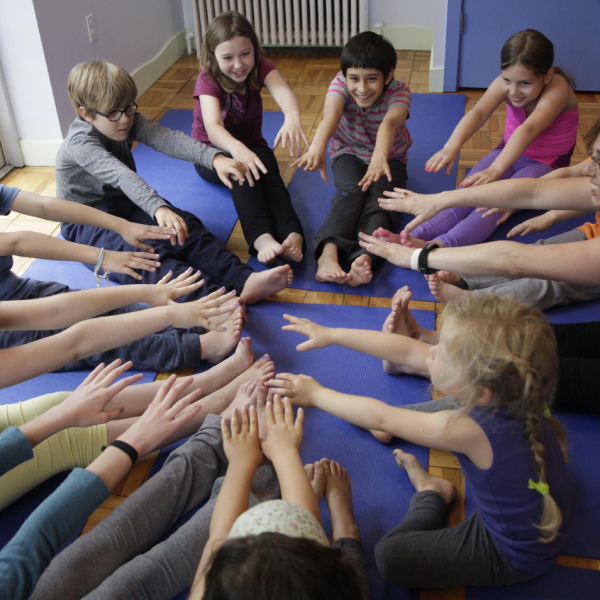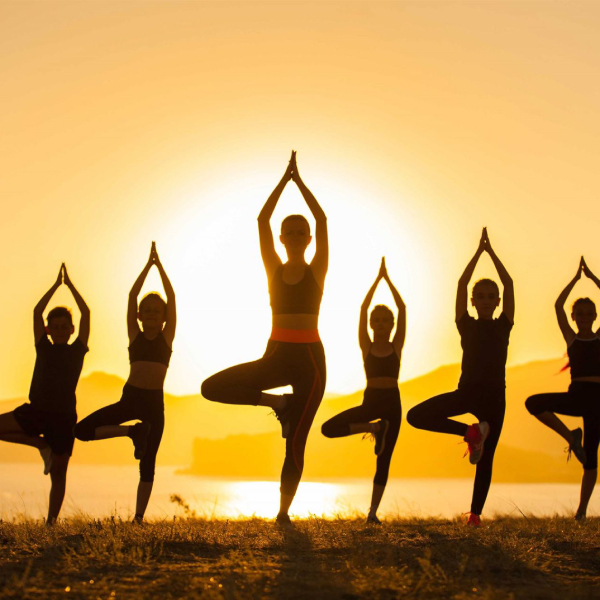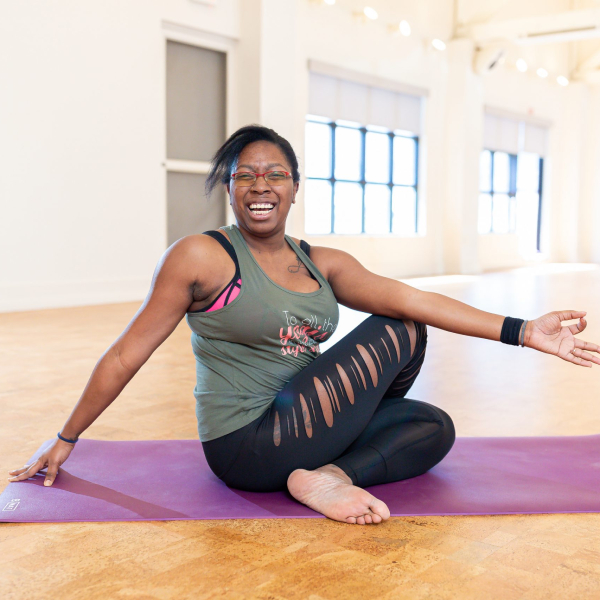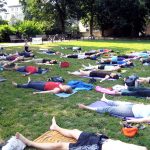Introduction to Yoga in the Circle
Yoga is evolving, and the circle is its latest trend. ‘Yoga in the circle’ brings a fresh perspective to an ancient practice. It symbolizes unity, wholeness, and infinity. This innovative approach encourages communal experiences and personal connections.

In traditional yoga, participants often focus inward and on their mats. Circle yoga changes this. It positions practitioners in a circle, facing each other. This layout fosters a sense of togetherness and support. It enables yogis to perform asanas while engaging with peers. As an SEO expert and blogger, I find this concept intriguing and inspiring.
Circle yoga is not just a physical practice; it’s a spiritual gathering. It combines traditional yoga poses with the symbolic power of the circle. Together, they enhance the yoga experience, deepen communal bonds, and promote harmony. It’s perfect for those seeking a yoga practice that is both inwardly and outwardly focused.
For seasoned yogis and beginners, this practice offers new challenges and rewards. It allows instructors to get creative with class structures and sequences. It also encourages students to develop their practice in a supportive environment. The circle provides a powerful space for growth and development. In the circle of life yoga, practitioners find inspiration to explore their limits and foster personal growth. This supportive community nurtures both seasoned yogis and newcomers alike.
In the upcoming sections, we will delve into the core benefits of this practice. As we explore circle yoga, remember its potential to transform your routine. Embrace the circle, and discover a new path to balance and unity in your yoga journey.
Core Benefits of Circle Yoga
Circle Yoga offers multiple profound benefits that enhance both personal practices and communal interactions. Primarily, it fosters a strong sense of community. Practitioners, positioned to face each other, share mutual support. This arrangement enforces empathy, encourages encouragement, and deepens connections between the participants. Such a setup differs greatly from traditional yoga, which often isolates students on individual mats.
Secondly, Circle Yoga promotes increased awareness and energy flow. The circular arrangement symbolizes an unbroken flow of energy, making the practice more dynamic and integrative. Practitioners tend to feel more engaged and part of a collective experience, enhancing their focus and participation levels. The yoga circle fosters a sense of community, enhancing energy exchange and connection among practitioners. This collective experience boosts focus and participation during the practice.
Additionally, this style of yoga adapts to all levels, providing accessibility to beginners and challenges for advanced yogis. Instructors have the freedom to innovate with sequences that maintain eye contact and interaction, which can be particularly motivating for new students.
Moreover, Circle Yoga also amplifies the spiritual aspects of the practice. The circle itself is a powerful symbol across various cultures, representing unity, infinity, and wholeness. Integrating this shape into yoga practice helps embody these concepts, enriching the spiritual journey of each yogi.

In summary, embracing yoga in the circle means embracing a practice that is communicative, inclusive, and rich with symbolic significance. It offers a distinctive approach that redefines traditional boundaries and enhances both individual and collective experiences.
Key Yoga Poses Adapted for Circular Practice
Yoga in the circle adapts key poses to fit the communal setup. This adaptation fosters interaction and collective energy flow within the group. Here, we discuss several traditional poses modified for this form of practice.
1. Warrior II (Virabhadrasana II): Typically, this pose faces one direction. In a circle, yogis face outward from the center. This allows participants to maintain eye contact and encourage each other, expanding the communal aspect of the practice.
2. Tree Pose (Vrikshasana): In circle yoga, this balancing act becomes a shared experience. Participants can pair up to balance and support each other, enhancing feelings of trust and togetherness.
3. Seated Forward Bend (Paschimottanasana): Traditionally done individually, in the circle it can promote unity. Participants can sit in a circular arrangement, holding hands or connecting in another way to perform the stretch together.
4. Circle Sun Salutation (Surya Namaskar): This flow can be choreographed so that practitioners move around the circle, facing inward or outward, fostering a dynamic and integrative energy flow.
Adapting these poses to the circle not only challenges the practitioners but also enhances the symbolic meaning of unity and connectivity inherent in circle yoga. Moreover, it keeps the practice fresh and engaging, appealing to both new and seasoned yogis.
Tools and Equipment for Circle Yoga
Circle Yoga may require specific tools and equipment to optimize the practice. Unlike traditional yoga that might need no more than a mat and your own body, yoga in the circle can benefit from added elements to enhance the communal experience.
1. Yoga Mats: Each participant will need a yoga mat. For the circle setup, mats are placed with the narrow ends pointing towards the center, encouraging a feeling of closeness and unity.
2. Yoga Blocks: Blocks can be used by practitioners to maintain poses with more ease or challenge, depending on their experience level.
3. Straps: Straps are helpful for maintaining alignment and extending reach in poses, especially when performed in a connected, circular fashion with other yogis.
4. Blankets: Providing blankets allows for comfort and warmth during meditation or relaxation phases of the practice.
5. Music and Sound Equipment: Soft, ambient music can be played to enhance the atmosphere. Ensure that speakers are positioned to distribute sound evenly across the circle.
6. Central Focus Point: An object or symbol such as a candle, flowers, or a statue can be placed in the center of the circle to serve as a shared focus point and enhance the sense of unity.
These tools and equipment not only facilitate physical support but also contribute to the creation of a sacred space. This sacred space is at the heart of yoga in the circle, elevating the practice from a mere exercise to a holistic and shared experience.
Incorporating Meditation and Mindfulness
The practice of yoga in the circle takes a holistic approach, integrating meditation and mindfulness into its core. This seamless melding of physical postures with mental focus cultivates a deeper level of inner peace and communal harmony. Below, we highlight the ways in which meditation and mindfulness are interwoven into circle yoga sessions.
Emphasizing Breath Work: Every session starts with deep breathing. It centers the mind and prepares the body.
Guided Meditation: Instructors often use guided meditation to lead the group. This strengthens the collective focus and nurtures a sense of shared spiritual space.

Mindfulness in Movement: Participants are encouraged to move mindfully, staying present in each pose. This builds awareness and connection.
Silent Observation: Periods of silence allow yogis to observe their thoughts passively. It enhances mindfulness and reduces stress.
Group Energy Awareness: Practicing in a circle, individuals become more attuned to the group’s energy. This shared awareness is a powerful aspect of yoga.
By blending meditation and mindfulness with physical poses, yoga in the circle cultivates a balanced experience. Participants leave feeling both physically refreshed and mentally replenished.
Designing a Circle Yoga Class
Designing a circle yoga class involves thoughtful planning and creativity. The goal is to foster a supportive, engaging environment. Here are steps to help you design an effective circle yoga session:
1. Determine the Class Size: Smaller groups enhance personal connection. Ideally, aim for 8-12 participants. This size maintains intimacy while allowing dynamic interactions.
2. Arrange the Space: Place yoga mats in a circle with ends pointing towards the center. Ensure each yogi has a clear view of others to promote connectedness.
3. Plan the Sequence: Integrate poses that encourage eye contact and interaction. Include both individual and collaborative poses to balance the session.
4. Incorporate Props: Use blocks, straps, or blankets as needed. These tools can help participants achieve poses more effectively and comfortably.
5. Focus on Thematic Elements: Maybe center the class around themes like ‘unity’ or ‘balance’. Use these themes to select poses and structure the meditation.
6. Set the Atmosphere: Use soft, ambient music and a central symbolic focus like a candle. These elements enhance the spiritual and communal feel of the class.
By carefully considering these aspects, you can create a yoga class that is not only physically fulfilling but also spiritually enriching.
Challenges and Opportunities in Circle Yoga
Like any new trend, yoga in the circle faces its share of challenges. Yet, these very challenges also reveal unique opportunities for growth and deepened practice. Addressing challenges head-on helps make yoga an even more rewarding experience.
Overcoming Spatial Limitations: One challenge comes with the need for ample space. Not all studios can accommodate a circle arrangement without feeling crowded. However, this invites the chance to take yoga outdoors or into larger community spaces, connecting with nature and others in new settings.
Adjusting to New Dynamics: The circular setup can be unfamiliar to practitioners used to solo practice. It shifts the dynamic from solitary to collaborative. Embracing this change can enhance one’s sense of community and open doors to forming deeper connections.
Teaching Adaptability: Instructors must adapt their methods for a circular format. This challenge presents an opportunity to innovate in yoga teaching. Instructors can grow professionally, exploring new ways to foster interaction and collective engagement.
Building a Circle Yoga Community: While finding participants may be tough at first, this is an opportunity to build a dedicated circle yoga community. Encouraging word-of-mouth, promoting inclusivity, and creating unique class experiences can attract a diverse group of yogis.
Maintaining Tradition Within Innovation: Integrating tradition with a new format invites scrutiny. Instructors have an opportunity to show how innovation like circle yoga can deepen the practice’s roots. This balance between old and new can lead to a richer, more integrated yoga experience.
In conclusion, each challenge that circle yoga presents is also an opportunity for growth. As the practice evolves, its ability to adapt will determine its lasting impact. By embracing both challenges and opportunities, yoga in the circle can enrich individuals and communities alike. The best yoga ball enhances stability, allowing practitioners to overcome challenges in circle yoga. Embracing this tool can further enrich personal and community growth through mindful practice.
Future Trends in Circle Yoga
As yoga in the circle gains popularity, its future looks bright with evolving trends. Here are the anticipated advancements:
- Technology Integration: Expect to see more virtual circle yoga sessions. Technology can bridge distances, allowing global participation in real-time.
- Hybrid Formats: A mix of in-person and virtual classes might become popular. This flexibility can cater to yogis worldwide.
- Therapeutic Applications: Yoga could be adapted for therapeutic settings. This would help patients in recovery connect and heal together.
- Eco-Friendly Practices: With the rise of environmental awareness, there may be more outdoor yoga sessions. These can deepen a connection with nature.
- Diverse Populations: Efforts to make circle yoga inclusive to diverse groups could intensify. Adapting yoga to suit different ages, abilities, and backgrounds is key.
- Advanced Training for Instructors: As the demand for yoga grows, so will the need for specialized training. This will ensure instructors are well-equipped to manage dynamic group energy.
These trends could make yoga a staple in modern wellness practices. As it evolves, the core values of community and connection will likely remain central to its philosophy.

